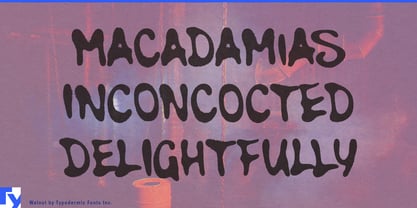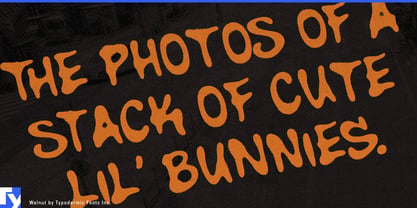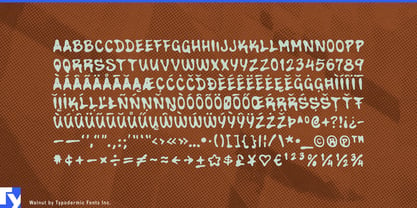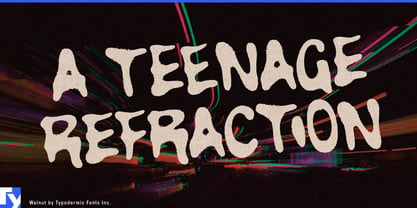Wählen Sie diesen Lizenztyp, wenn Sie eine app für iOS, Android oder Windows Phone entwickeln und Sie die Datei Font in den Code Ihrer mobilen Anwendung einbetten.
Walnut
von Typodermic






Über die Schriftfamilie Walnut
Wir stellen vor: Walnut - das Graffiti Schrift , das es in sich hat! Dieses Font wurde nicht für schwache Nerven entwickelt. Es ist hart, rau und unverblümt. Der düstere, aufgesprühte Look von Walnut verleiht Ihren Designs eine raue Kante, die die Leute aufhorchen lässt.
Mit seinem realistischen Stil sieht Walnut so aus, als wäre er gerade aus der Wand gesprungen und bereit, der ahnungslosen Öffentlichkeit Unheil zuzufügen. Es ist das perfekte Schrift für jedes Designprojekt, das einen Hauch von Vandalismus erfordert. Von Postern bis hin zu album - Walnut verleiht Ihren Arbeiten das gewisse Etwas, das sie von der Masse abhebt.
Aber was Walnut wirklich auszeichnet, sind seine einzigartigen Kombinationen. Dank der Unterstützung von OpenType-Ligaturen erstellt Walnut benutzerdefinierte Buchstabenkombinationen, die aussehen, als wären sie spontan mit einer Sprühdose erstellt worden. Jedes Zeichen hat eine eigene Persönlichkeit, so dass sich diese Font perfekt für die Erstellung individueller Logos oder Überschriften eignet, die Aufmerksamkeit erregen.
Warum sollten Sie sich also mit einem langweiligen, vorhersehbaren Schrift zufrieden geben, wenn Sie die Kraft von Walnut entfesseln können? Es ist an der Zeit, Ihre Entwürfe auf die nächste Stufe zu heben und mit diesem robusten und kernigen Schrift ein Statement abzugeben. Machen Sie sich bereit, mit Walnut Lärm zu machen!
Die meisten europäischen Schriftsysteme auf Lateinbasis werden unterstützt, darunter die folgenden Sprachen. Afaan Oromo, Afar, Afrikaans, Albanisch, Elsässisch, Aromanisch, Aymara, Baschkirisch (lateinisch), Baskisch, Weißrussisch (lateinisch), Bemba, Bikol, Bosnisch, Bretonisch, Kap Verdeisch, Kreolisch, Katalanisch, Cebuano, Chamorro, Chavacano, Chichewa, Krimtatarisch (Latein), Kroatisch, Tschechisch, Dänisch, Dawan, Dholuo, Niederländisch, Englisch, Estnisch, Färöisch, Fidschianisch, Filipino, Finnisch, Französisch, Friesisch, Friaulisch, Gagauz (Latein), Galizisch, Ganda, Genuesisch, Deutsch, Grönländisch, Guadeloupeanisches Kreol, Haitianisches Kreol, Hawaiianisch, Hiligaynon, Ungarisch, Isländisch, Ilocano, Indonesisch, Irisch, Italienisch, Jamaikanisch, Kaqchikel, Karakalpak (Latein), Kaschubisch, Kikongo, Kinyarwanda, Kirundi, Kurdisch (Latein), Lettisch, Litauisch, Lombardisch, Niedersächsisch, Luxemburgisch, Maasai, Makhuwa, Malaiisch, Maltesisch, Māori, Moldawisch, Montenegrinisch, Ndebele, Neapolitanisch, Norwegisch, Novial, Okzitanisch, Ossetisch (Latein), Papiamento, Piemontesisch, Polnisch, Portugiesisch, Quechua, Rarotonganisch, Rumänisch, Rätoromanisch, Sami, Sango, Saramaccanisch, Sardisch, Schottisch-Gälisch, Serbisch (Latein), Shona, Sizilianisch, Schlesisch, Slowakisch, Slowenisch, Somalisch, Sorbisch, Sotho, Spanisch, Swahili, Swazi, Schwedisch, Tagalog, Tahitianisch, Tetum, Tonganisch, Tshiluba, Tsonga, Tswana, Tumbuka, Türkisch, Turkmenisch (lateinisch), Tuvaluisch, Usbekisch (lateinisch), Venezianisch, Vepsisch, Võro, Wallonisch, Waray-Waray, Wayuu, Walisisch, Wolof, Xhosa, Yapese, Zapotec Zulu und Zuni.
Designer: Ray Larabie
Herausgeber: Typodermic
Foundry: Typodermic
Eigentümer des Designs: Typodermic
MyFonts Debüt: Februar 26, 2007

Über Typodermic
Willkommen bei Typodermic Fonts, einer temperamentvollen Schrift Foundry mit Sitz in Nagoya, Japan, wurde 2001 von dem kanadischen Schrift Designer Raymond Larabie gegründet. Unsere Bibliothek umfasst mehr als 500 verschiedene Schriften , die die Kreativität in den Bereichen Grafikdesign, Werbung, Web und app Entwicklung anregen. Als Pioniere des digitalen Schriftdesigns haben wir Fonts und app Lizenzierung schon früh eingesetzt und dabei immer wieder neue Wege beschritten. Mit kanadischem Herz und japanischer Präzision sind wir Ihr globaler Partner für außergewöhnliche Typografie. Entdecken Sie Typodermic Fonts- wo Kreativität auf Charakter trifft.
Mehr lesen
Weniger lesen